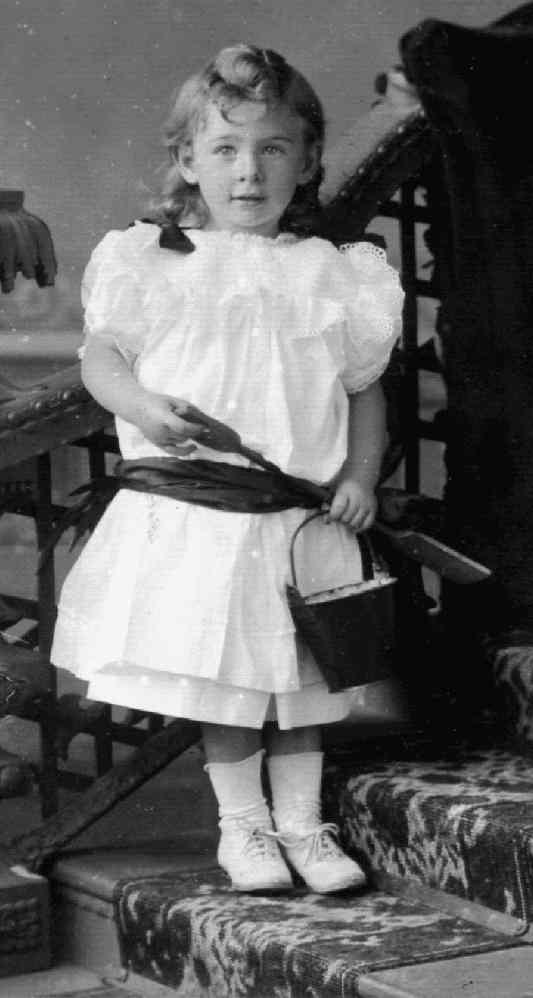
Boys' Hair Styles: Pig Tails

Figure 1.--This charming portrait shows pigtails being worn by a little English boy wearing pigtails. The portrait was taken in 1898. Notice the colored velvet hair boy on his shoulder, placed there by his mother so it would show in the photograph. Bertie was nearly 3 years old. Click on the image for a fuller discussion of the fashions involved.
|
Pigtails or queues have been worn by men and women as well as boys and girls in many different societies over time. In modern America the pig tail is primarily seen as a young girls hair style symbolized in the popular mind with Cindy from the 1970s "Brady Bunch" TV sitcom. Europeans might identify more with Pipi Longstockings. What ever the case the style is seen as a girl's style. This has not, however, alwats been the case throughout history.
Ancient Civilizations
Pigtails and braids were worn by the Egyptians, although we do not know if they were the first civilization to adopt the style. Both noblemen and ladies kept their hair cut short, in part to keep cool in the sultry Egyptian climate. They also had black wigs to protect their scalps from sunburn. For ceremonial occasions they made elaborate braids in the wigs and adorned with fresh flowers, gold ornaments, and other decirations. I am not sure about boys, but they appaer to have worn a side lock. Braided hair in Rome was a woman's style. Women pileed their hair up in braids on top of their heads. They might also dye it with yellow soap or use the hair of blond slaves captured in norther Europe.
Islam
Braided hair was also a style for Muslim women. Thet mighr wash their hair in a henna rinse. It would ne modestly conceal under a turban or veil. The braided pigtail style helped to prevent it from falling on their face.
Native Americans
The Plains Indians of North America wore two long pigtails. Aztec women in Mexico commonly braided their hair, with colored material, and they wound the braids
around their heads. This practice is still seen in Mexico.is still done in many parts of Mexico.
The Manchu Dynasty upon conquring China in 1644 the following year demanded that Chinese men adopt the Manchu piftail as an act of sunmission. Chinese boys and men until the Revolution were fanous for wearing plaited pigtails. Chinese men shaved the front of their head, then combed the back hair into braids. They used not only their
own natural hair, but also horsehair or black silk. The Chinese came to see their braided pigtails a sign of dignity and manhood. For the Chinese, to pull on another's
pigtails was a great insult. Unmarried Chinese girls also often wore their hair in pigtails. It was a pervasive style in the 19th century. Most Chinese immigrants that
came to America in the 19th century had these plaited pigtails.
Japanese
Perhaps influenced by the Chinese, Japanese men commonly shaved the front of their head. Curiously, instead of a long braided pig tail, they chose a little stiff pigtail at the back of the head.
Africans
Wariots in some African tribes tieed their hair into three sections of tiny braids,
then put one waist length braid in the back. Such a hairstyle could take hours to get just right and thus might not be altered for weeks.
Europeans
The Church in Europe had a major influece on both hair styles and clothing. In Renaissance Europe, the Church encouraged married noblewomen to be modest, and to wear a veil over their hair often done in pigtails. These were often inter-laced with ribbons and sometimes augmented with human or animal hair. By the 13th and 14th centuries it was common for women to wear braided pigtails coiled around the ears and bundled into gold or silver nets. Pig tails or queues were commonly worn by men and boys in the 18th century. They were not a juvenile style, however, but worn by men and boys. Commonly there was just one rather than the twin style. HBC has not noted pig tails in the 19th centuty after the first decade. By this time, long hair was becoming less common for boys, so pig tails were not a common style. In the late 19th century when long hair for boys was more common, very few boys wore their hair done in pig tails. We do note them reappearing around the turn of the 20th century, but were more common after World War I (1914-18). Pig tails in the 20th century were, however, a girls' hair style. A few younger boys in the very late 19th or early 20th centuries wore them, but this was not very common. Hair bows might be added to the pig tails. We have noticed some boys in the 1990s, mostly older teenagers, wearing long hair in a single pig tail.
Americans boys might wear a single pigtail in the 18th century following the same conventions as Europeans. This disappeared in the 19th century as men an boys began to wear shorter hair. We have few images from the early 19th century. We do begin to note younger boys wearing pig tails in the late 19th and early 20th century. This was not a common style, but we do notice a few examples. In some case the images that we have found do not clearly identify the child as a boy. In some cases it is difficult to tell.
Sources
Bowen, J.T. "Pigtails: from noblemen to unmarried Chinese women," The Pendulum Online (Elon University) February 21, 2002.
Severn, Bill. The Long and Short of It.
HBC

Navigate the Boys' Historical Clothing Web Site:
[Return to the Main boys' hair style page]
[Introduction]
[Activities]
[Biographies]
[Chronology]
[Clothing styles]
[Countries]
[Literary]
[Bibliographies]
[Contributions]
[Essays]
[FAQs]
[Glossaries]
[Satellite sites]
[Tools]
[Boys' Clothing Home]
Created: September 17, 2001
Last updated: 12:24 AM 1/22/2005



